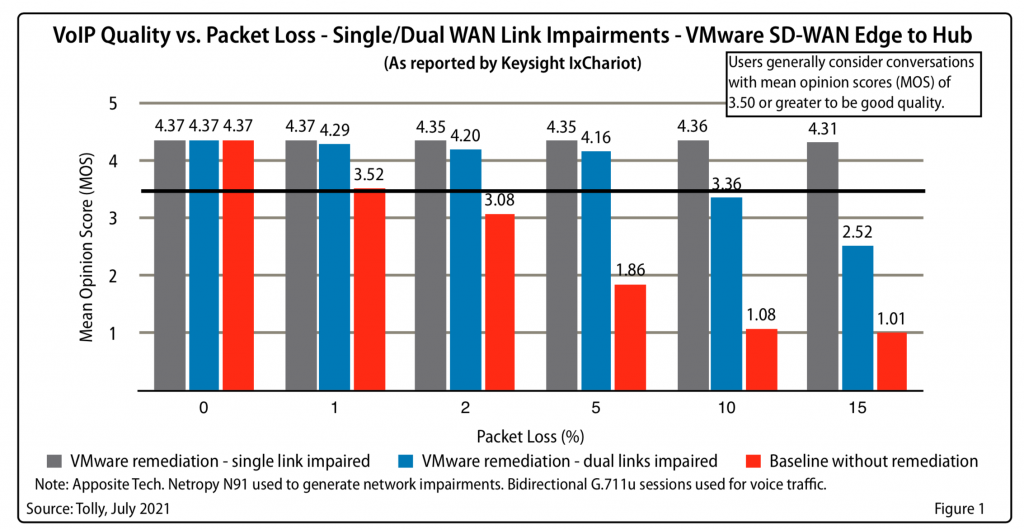Updated 8/25/2022
Combining the power of dual links with VMware SD-WAN delivers tremendous benefits.
Report highlights
- Tolly Group testing proved that VMware SD-WAN can successfully remediate significant packet loss and latency/jitter for VoIP calls over dual WAN links
- Even with 10% packet loss on both links, VMware SD-WAN maintained a good voice quality score
Guest post by Kevin Tolly, Founder, The Tolly Group
The flexibility and ease-of-use of SD-WAN has made it extraordinarily popular as the “next-gen” WAN for organizations large and small. SD-WAN’s network overlay topology can also provide significant benefits for end-user experience while maintaining solid throughput performance. VMware SD-WAN™, a service of VMware SASE™, automatically remediates packet loss and delivers a high-quality experience even under adverse network conditions. Dual WAN link deployments are very economical and further enhance the user experience by providing even greater flexibility, robustness, and higher aggregate throughput.
In this blog post, I will give you an overview of the test results. You can also read our full Tolly report #221128 for all of the details.
The testing encompassed three areas:
- Voice quality in the face of WAN (Internet) packet loss and latency/jitter on one or both links
- Dual WAN link optimization
- 10GbE packet throughput benchmarking between an edge and a hub appliance
VMware SD-WAN demonstrated that it could successfully remediate significant packet loss and latency/jitter for VoIP calls, completed a file download despite a link failure, and was able to aggregate both the links to support a large file transfer greater than the actual bandwidth of the link. This confirms that VMware SD-WAN delivers significant resiliency and performance benefits using dual WAN links and matched its data sheet throughput specifications with respect to raw edge-to-hub throughput.
Here are some highlights. Please see the full Tolly report for all of the test results.
A MOS score of 3.5 out of 5.0 and above is considered very good.
Impact of packet loss on VoIP (voice) quality
VMware SD-WAN results due to packet loss
After running a set of baseline tests, the same set of tests were run through the VMware SD-WAN solution using the default policies that provide on-demand remediation for packet loss. See Figure 1.
With packet loss present on a single link, the voice quality without any loss of 4.37 was maintained throughout all the loss scenarios. Even with loss on a single link of 15%, the voice quality score was 4.31 as VMware SD-WAN dynamically sent traffic over the better link.
With packet loss present on both links, the results remained impressive. Even with 5% loss, the MOS is 4.16 — not far below the zero-loss score of 4.37.
With 10% loss, the MOS of 3.36 remains very close to the “good” level of 3.50.

Dual WAN link optimization
Combining the power of dual links with VMware SD-WAN delivers tremendous benefits. Users have a more robust network that delivers higher aggregate throughput and automatically selects the optimum link in response to network conditions and application needs. This set of tests exercised some key capabilities and all ran flawlessly. For the summary results, see Table 1.
Prefer low latency link
With links to different ISPs, it is not uncommon for one link to be degraded by excessive latency. While monitoring traffic, the Netropy impairment generator was used to add 250ms of latency to the active link. Tolly engineers confirmed that traffic was dynamically migrated by VMware SD-WAN to the other link that had lower latency.
Uninterrupted download with failed link
Some data transfers can take an extended amount of time — file backups are a common example. For this test, engineers started transferring a large file and confirmed link activity. The file was a video (mp4) file of approximately 250 MB and was downloaded from Microsoft OneDrive. While the transfer was still in progress, that link was physically disconnected. Tolly engineers confirmed that the file transfer continued without interruption as VMware SD-WAN dynamically used the alternate link to complete the transfer.
Dual WAN link aggregate bandwidth for a single app
An important benefit of leveraging two links is the ability to harness additional bandwidth. Traditionally, application traffic would be bound to a single link. VMware SD-WAN can dynamically and transparently aggregate dual links to benefit a single application. For this test, Tolly engineers started a large file transfer and confirmed that the aggregate application throughput exceeded the capacity of either single link.

Working from anywhere will only continue to gain in importance going forward. It is essential that solutions work as advertised. Third-party tests like these provide additional assurance for users that their environments are robust and resilient.
Learn more
- Download the full Tolly report from the VMware website.
- Visualize how VMware SD-WAN, VMware SASE and Intel developer tools work together for a smooth user experience in Tolly Group’s infographic.







